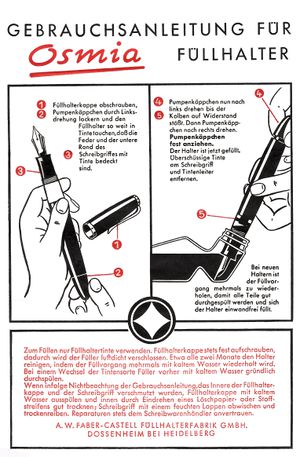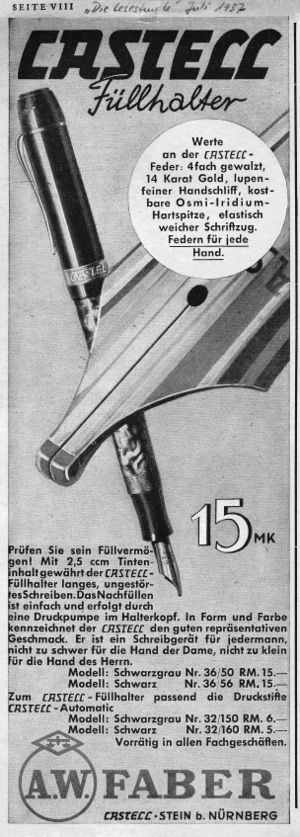Differenze tra le versioni di "Osmia/en"
(Creata pagina con 'In the late '30s, because of World War II, like all other German manufacturers the company suffered major difficulties, but despite the production was reduced for the call to ...') |
(Creata pagina con 'Since 1949 Faber-Castell also began producing ballpoint pens, and in 1950 introduced a torpedo shaped model, called Gentleman in black or gray pearl and silver. The pe...') |
||
| Riga 42: | Riga 42: | ||
In the late '30s, because of World War II, like all other German manufacturers the company suffered major difficulties, but despite the production was reduced for the call to arms of most of the employees, it remained active. After the war, not having the facilities suffered significant damage, production was resumed at full speed from 1946, proposing the same models of before, but with only with a [[piston filler]] and with the explicit endorsement (in addition to the [[Osmia]] brand and logo) of ''A. W. Faber-Castell''. | In the late '30s, because of World War II, like all other German manufacturers the company suffered major difficulties, but despite the production was reduced for the call to arms of most of the employees, it remained active. After the war, not having the facilities suffered significant damage, production was resumed at full speed from 1946, proposing the same models of before, but with only with a [[piston filler]] and with the explicit endorsement (in addition to the [[Osmia]] brand and logo) of ''A. W. Faber-Castell''. | ||
| − | + | Since 1949 [[Faber-Castell]] also began producing ballpoint pens, and in 1950 introduced a torpedo shaped model, called [[Gentleman]] in black or gray pearl and silver. The pen had revolutionary features like a butterfly shaped clip and a particular [[piston filler]] which contained part of the mechanism in the knob, allowing a greatest dimension of the tank; it was made with a transparent body covered by an opaque plastic cylinder with a regular series of etchings that at the same time had the role of facilitating the grip of the pen and allow viewing the ink level. | |
Negli anni '50 la [[Osmia]] introdusse una serie di nuovi modelli, come la [[Supra 880]], in tre misure (2, 3 e 4) di colore nero con vera sul cappuccio e indicatore del livello di inchiostro, la [[Supra 666]] in quattro misure (1, 2, 3 e 4), di colori nero, grigio perla e rosso perla, con vere sul cappuccio e pennini in oro e acciaio, la [[Osmia 744]] in plastica nera intagliata, progettata per eseguire copie carbone e la [[Osmia 52]], per il mercato studentesco. | Negli anni '50 la [[Osmia]] introdusse una serie di nuovi modelli, come la [[Supra 880]], in tre misure (2, 3 e 4) di colore nero con vera sul cappuccio e indicatore del livello di inchiostro, la [[Supra 666]] in quattro misure (1, 2, 3 e 4), di colori nero, grigio perla e rosso perla, con vere sul cappuccio e pennini in oro e acciaio, la [[Osmia 744]] in plastica nera intagliata, progettata per eseguire copie carbone e la [[Osmia 52]], per il mercato studentesco. | ||
Versione delle 14:50, 2 apr 2012
Osmia was founded in 1919, while the activities of Faber-Castell went back to the eighteenth century. The Osmia was born as fountain pen producer, while Faber-Castell is still known mainly for its work as a producer of pencils, carried out continuously from its origins. Since 1935 the Osmia essentially became a division of Faber-Castell, although the company survived for a long time, until the 1951.
Osmia had been one of the leading German fountain pens manufacturers, and because the prestige of the brand, due to the absolute quality of his pens, the name was maintained for a long time after the complete acquisition by Faber-Castell. It disappeared only in the early '60s, when the crisis derived from the success of the ballpoint pen pushed Faber-Castell to produce cheaper models. Fountain pen production ceased definitively in 1975 when Faber-Castell, during a corporation restructuring, eliminated this area to focus on its other activities, restarting production recently, when the interest on fountain pens began to rise again.
| Osmia |
|---|
| Brand pages |
| Brand advertising |
| Brand photos |
| Instructions sheet |
| Other documents |
| Patents |
History
Faber-Castell origins are traced back to 1761 when Kaspar Faber began a production of pencils in Stein, a village located close to Nuremberg. The activity was developed by his son Anton Wilhelm, who created the A. W. Faber company, and then passed to his son. The real architects of the company success, however, was the grandson Lothar von Faber, which took the direction of a declining company and with the invention of modern wooden pencil, remained unchanged to this day, built the success of the A. W. Faber brand.
In the mid of 1800 Faber-Castell was already a large international company, directed by Lothar von Faber with the help of its brothers Johan and Eberhard Faber. Both Eberhard and Johan created their own companies, the first in New York, where he went to direct the U.S. subsidiary of the mother company, always producing pencils, the second in Nuremberg, where in 1878 he founded a personal company, which in 1885 became a family limited partnership, the Johan A. Faber A.G..
Johan Faber started also a production of fountain pens around '20s; they were mainly safety hard rubber pens but a button filler was also produced; also some metal model were produced. The company logo consisted of two crossed hammers, and on the hard rubber models cap the name Johan Faber was imprinted, and also reported on the clip. In the late '20s a piston filler series was produced, with rounded ends and up to four band on the cap.
The main branch of the company remained under Lothar Faber direction until his death, after that his wife took over the management and then, in 1898, the count Alexander zu Castell, who had married his niece. He renamed the company using the name under which its is still known today, transforming it into the A. W. Faber-Castell. The production, however, remained focused on pencils, and the first fountain pen, a hard rubber safety pen, is traced back to 1908. The pen was imprinted with the words A. W. Faber-Castell and given the similarity of its filling mechanism, is quite probable that it had been produced by Kaweco on commission.
After the death of Alexander Castell in 1929 the company became a family limited partnership. His son Roland obtained between 1931 and 1932 the reunification between the A. W. Faber-Castell and the Johan Faber A. G., giving life to the actual Faber-Castell. In 1935 Faber-Castell began to buy shares of the Osmia A. G., that at that time was between the major German fountain pen producers, taking control over the company in order to have a strong starting point in pens manufacturing.
Osmia was founded in 1919 by Hermann Böhler under the name of Böhler und Cie, in Dossenheim, near Heidelberg. Böhler, as many others of his colleagues who made a similar choice, left Kaweco to create a new company with his brother Georg, leveraging the expertise gained in this field inside Kaweco during the years in which that company acquired Morton to realize a production of gold nibs.
The initial Osmia production consisted primarily of mechanical pencils and hard rubber safety pens. The Osmia logo was a diamond placed inside a circle. It has been reported[1] that the first version of the logo consisted in a convex Greek cross, given the similarity with its own logo Osmia was brought to court by Montblanc, that required a very high compensation and the complete destruction of the entire production. That would have destroyed the company, but the case was resolved with an agreement and Böhler had to change the symbol transforming the cross in a diamond.

The company name, Osmia, derived from a special metal alloy, called Osmiumalloy for which the Böhler brothers obtained the use thanks to a patent of the Heraeus company in Hanau,[2] The Osmiumalloy was used widely for the tips of the Osmia nibs, and the alloy, though much more expensive, had a much higher quality respect to natural iridium then available in Germany (which contained many impurities that it favoured wear), and allowed the company to provide a lifetime warranty on their pens.
Osmia had a great initial success, becoming in a short time the second largest producer of pens in the country, so that a plant was specially created to produce pens. In the late '20s however sales had slowed and margins were weak, so the company went into financial troubles. In this period Parker, who was trying to expand its business into Europe, began to take an interest in Osmia which was acquired (or with whom took an interest, sources are unclear) in 1928. In this period the company produced the Duofold for the European market, characterized by the imprint Parker - Osmia A. G. Heidelberg.
During the same period the company continued to produce under the Osmia brand, with mottled hard rubber safety pens, lever filler pens and mechanical pencils, which remained the original logo on the cap. Around 1930, Parker withdrew because the sales of Duofold did not have a great success because of a price too high for the German market, and a too rigid nib. The activity went on (or was given) to Osmia Gmbh, again under the direction of the Böhler brothers. It was launched a new line, the Osmia Supra, similar to the Duofold, with an improved button filler, and a brass enameled logo on top of the cap.
In 1932, facing financial difficulties for the return of investment to the Parker, the nib factory was sold to Degussa. In 1933 the pen style was amended to follow the streamlined trend also used by Duofold of the same time. Were also launched other models: the Luxus line, a torpedo-shaped piston filler, and the the Osmia Progress, with a filling system similar to the Vacumatic one. Despite the financial troubles due to end of the cooperation with Parker, Osmia got a good selling success.
Since 1935 the company was gradually acquired by Faber-Castell, even if the final sale of all ownership was made only in 1951. The fountain pens took the inscription A. W. Faber-Castell Dossenheim but nevertheless the continued to bear the Osmia brand and logo, which was well known and respected, until the '60s. In 1938 Hermann Böhler resigned from Osmia to found in Dossenheim another company with its name that produced pens and automatic pencils.
Despite the acquisition of Osmia, Faber-Castell also produced some model with just its brand, in 1936 was produced a model with the Faber-Castell name engraved on all parts of the pen, available in four colors, the pen was a piston filler with and finishes (band and clip) in 14k gold, and bore the logo of the company, a balance that represented trade integrity.

Most of the production of Faber-Castell fountain pens was however done with Osmia trademark. In 1935 were introduced several models with different filling systems. Using the piston filler were: the Supra Luxus in chiseled black celluloid, produced in the 42, 44 and 46 measures, the Supra in the black or blue or silver or gold colors, with a black cross-striped transparent section produced in the 72, 74, 76, and 78 measures, the Osmia similar to the Supra but only in black celluloid and in 62, 64, 66 measures, and the Osmia, black, in 54, 55 and 56 measures.
Using a membrane filling system were the Supra Progress in plain colors (black, green, red, gray, blue, silver and gold) and 192, 193, 194 and 196 measures, and the Progress in the 92, 93, 94 and 96 measures. Finally using the button filler the Brilliant produced in black, gold, red and green and 232, 126, 127 and 128 measures.
In the late '30s, because of World War II, like all other German manufacturers the company suffered major difficulties, but despite the production was reduced for the call to arms of most of the employees, it remained active. After the war, not having the facilities suffered significant damage, production was resumed at full speed from 1946, proposing the same models of before, but with only with a piston filler and with the explicit endorsement (in addition to the Osmia brand and logo) of A. W. Faber-Castell.
Since 1949 Faber-Castell also began producing ballpoint pens, and in 1950 introduced a torpedo shaped model, called Gentleman in black or gray pearl and silver. The pen had revolutionary features like a butterfly shaped clip and a particular piston filler which contained part of the mechanism in the knob, allowing a greatest dimension of the tank; it was made with a transparent body covered by an opaque plastic cylinder with a regular series of etchings that at the same time had the role of facilitating the grip of the pen and allow viewing the ink level.
Negli anni '50 la Osmia introdusse una serie di nuovi modelli, come la Supra 880, in tre misure (2, 3 e 4) di colore nero con vera sul cappuccio e indicatore del livello di inchiostro, la Supra 666 in quattro misure (1, 2, 3 e 4), di colori nero, grigio perla e rosso perla, con vere sul cappuccio e pennini in oro e acciaio, la Osmia 744 in plastica nera intagliata, progettata per eseguire copie carbone e la Osmia 52, per il mercato studentesco.
A partire dal 1955 vennero introdotti due modelli più affusolati, i più prestigiosi, che miravano a competere con le Montblanc 146 e 149, erano il 446 ed il 448, con tre vere ed il marchio inciso sul cappuccio, pennino oro bicolore e fermaglio diritto. A queste seguivano i modelli di fascia media 882, 883 e 884, in colore nero o verde rigato, una vera larga sul cappuccio e clip a becco.
All'inizio degli anni '60 il marchio Osmia non venne più utilizzato e vennero introdotti una serie di modelli a pennino coperto marchiati direttamente A. W. Faber-Castell, dotati di sezione trasparente per la visualizzazione del livello di inchiostro, più sottili rispetto alle versioni precedenti e realizzati in plastica a stampo. La linea di lusso venne denominata 66, aveva il corpo in plastica nera, rossa, blu o verde, il cappuccio laminato ed il pennino in oro; i modelli di fascia media vennero chiamati Faber-Castell Progress e prodotti in tre versioni, la 77S in plastica con pennino in acciaio, la 55S con cappuccio in argento e corpo in plastica e pennino in acciao, e la 55G con pennino in oro. Venne prodotta anche una versione per studenti denominata 54VT (da Vest Tank) un serbatoio di riserva usabile tramite una valvola.
Alla fine degli anni '60, come avveniva per la gran parte di tutti gli altri produttori di penne stilografiche, avendo per di più completamente cancellato un marchio prestigioso che godeva di una vasta popolarità, le vendite declinarono in maniera irreversibile, reggendo solo parzialmente per le penne destinate agli studenti. Nel 1975, nel corso di una ristrutturazione aziendale, la Faber-Castell eliminò completamente l'intero settore di produzione delle stilografiche, salvo riprendere la produzione ai nostri giorni, con il ritorno in voga di questo strumento di scrittura.
Template:CronoMarche |- | 1761 || Nascita della Faber-Castell |- | 1878 || Nascita della Johan Faber A. G. |- | 1898 || Alexander Castell trasforma la A. W. Faber nella A. W. Faber-Castell |- | 1919 || Nascita della Osmia come Böhler und Cie |- | 1928 || La Parker acquisisce la Osmia per la produzione in Europa |- | 1930 || La Parker rivende la Osmia che diventa la Osmia Gmbh. |- | 1931/32 || Riunificate la A. W. Faber-Castell e la Johan Faber A. G. |- | 1935 || La Faber-Castell acquisisce la Osmia |- | 1935 || La Osmia introduce i modelli Supra Luxus, Supra, Osmia, Osmia Brilliant a stantuffo |- | 1935 || La Osmia introduce i modelli Supra Progress e Progress a membrana e Brilliant a pulsante di fondo |- | 1950 || La Faber-Castell introduce il modello Gentleman |- | 1951 || La Faber-Castell incorpora ufficialmente la Osmia |- | 1975 || La Faber-Castell cessa la produzione di stilografiche |- |}
Template:LegendaModelli |- | Supra || 1935 || |- |}
Note
Riferimenti esterni
- [1] La storia della Faber-Castell, dal sito ufficiale
- [2] Un articolo di FPN sulla storia del fiduciario europeo di Parker nelle relazioni con Osmia
